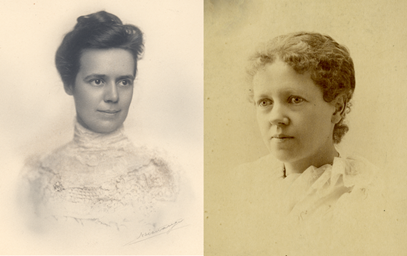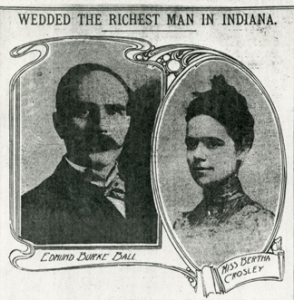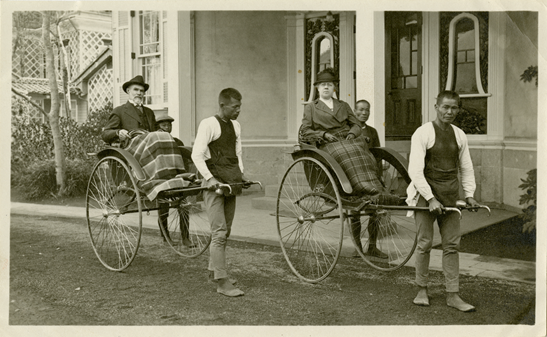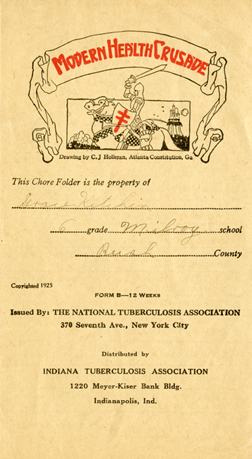As the United States exited the Gay Nineties and entered the 20th century, an increased concern for better systems of disease control and education swept the nation. As industry boomed, more and more people crowded into cities, both large and small. With crowds came germs and disease. Soon tuberculosis ranked as the leading cause of death in the country.
In Muncie, Indiana anxiety over bacterial diseases loomed just as large as in major cities like New York and Chicago. To combat these and other public health issues of the time, individuals stepped up to the plate and played vital roles in getting new organizations off the ground.

By the early 1900s the term “Ball jar” had become a household phrase, and Ball Brothers Manufacturing Company distinguished themselves as the largest producer of canning jars in the world. In addition to the successful business bearing their name, the Ball family also left their mark on Muncie through civic work and philanthropy. During the first decades of the 20th century two notable women of the Ball family worked to improve public health in their region, and personally invested time and energy into advancing sanitation, hygiene, and medical access.

Bertha Crosley Ball was the wife of Edmund Burke Ball – the middle son of the Ball brothers. Born in 1875 in Terre Haute, she was the daughter of a well-known Universalist minister and had familial roots stretching back to the American Revolution. Her advantaged upbringing left her wanting for very little in her youth. After graduating high school she began her collegial studies at Vassar College where she received a degree in Social Work in 1898.

After completing her studies, Bertha moved with her parents to Indianapolis where her father served as state superintendent of the Universalist Church of Indiana. Shortly after, Bertha made a visit to her friend Bessie Ball in Muncie. There, Bertha was introduced to Bessie’s brother-in-law, Edmund. Despite a twenty year age difference the two hit it off right away and in 1903 the couple married. Edmund’s distinction as the wealthiest man in Indiana, led to many headlines stretching from Indianapolis to Muncie, and even into Cincinnati.
Contrasted with Bertha’s advantaged upbringing is that of her sister-in-law, Sarah Rogers Ball. Nearly twenty years older than Bertha, Sarah married Edmund’s older brother, Dr. Lucius Ball in 1893. Born in upstate New York, Sarah was the daughter of immigrants. With six siblings, Sarah’s childhood home grew crowded and did not come with many opportunities. By the age of 16 she had moved into the home of her older sister and brother-in-law. For Sarah this move opened up doors that had been previously closed. Her brother-in-law, himself the son of immigrants, made a name as a ship captain and built up a very profitable shipping fleet. When Sarah began studies at the Buffalo General Hospital School of Nursing in 1885 her sister and brother-in-law likely paid the tuition.

While Bertha and Sarah could not be more different on the surface, their interest in public health and service to their community tied them together. In the 1880s the discovery of natural gas created a boom of industry in the Muncie area. This development led to a period of growth and an expanding population that required social amenities and services, such as health care. Over the next few decades small hospitals came and went until Ball Memorial Hospital opened its modern facility in 1929. In the meantime, it became obvious that the industrial town not only needed reliable hospitals, but also advocates for improving the overall public health of the community.
Two such promoters came in the form of Muncie’s Visiting Nurses Association and the Delaware County Tuberculosis Association. Both organizations tackled issues of public health, and felt the influence of Bertha and Sarah Ball.
Formed in 1916, the Visiting Nurses Association existed “for the benefit and assistance of those otherwise unable to secure skilled assistance in times of illness; to promote cleanliness and prevent sickness by the teaching of hygiene, sanitation and the science of domestic management.” To accomplish these feats they provided general nursing, maternity service, child welfare service, nurses training, and a mental hygiene program.
Among those involved with the organization of the association was Sarah. As a former nurse it comes as no surprise that she had an interest in seeing the group established. When living in Buffalo, she had been involved in organizing a local Visiting Nurses Association as well.

While Sarah’s role with the Visiting Nurses was low-profile, Bertha’s involvement was not. At the time of the group’s founding, the organization elected Bertha to serve as second vice president and she continued to actively serve on the board of directors into the mid-1930s; serving as president in the 1920s. Between 1922 and 1932 the association experienced rapid growth. Under Bertha’s leadership nursing staff expanded, the numbers of patients served grew, and community health rapidly improved.

Three years after the founding of the Visiting Nurses, the Delaware County Tuberculosis Association began to develop. With tuberculosis-related deaths on the rise, the group hoped to spread knowledge concerning the disease’s cause and treatment, and to take steps towards preventing its spread. Through lectures, anti-spitting campaigns, advertisements, tuberculin testing of cattle, and instructive visits from nurses, the association tackled its goals head on. Over time their work paid off and by the 1940s tuberculosis-related deaths in the county had almost completely disappeared.
In the association’s first years, Bertha and Sarah again found themselves highly involved. Both women helped incorporate the organization and were also among the first board members. Sarah personally offered up the use of her automobile to the organization, and Bertha regularly gave monetary gifts to the group when they struggled financially.

A scan of both organizations’ records show Bertha and Sarah’s names regularly mentioned in formative years. Through their labor, a strong foundation was established for both organizations, cooperative relationships developed between the boards, and both associations experienced rapid growth. With backgrounds in social work and nursing, Bertha and Sarah each possessed an understanding of society’s larger public needs and desired to improve the well-being of all people. Through their work, public health efforts in the Muncie area improved, leading to an established concern with human and community health that continues today.
